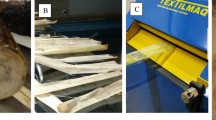Abstract
Self-bonding boards were manufactured with treated fibers at different concentrations of a laccase enzyme. This enzyme induced the generation of phenoxy radicals in the fiber lignin which can generate covalent bonds and cross-linked by radical–radical coupling. The effect of laccase concentration on the properties of obtained fiberboards was evaluated. The formation of free radicals and changes in the lignin macromolecule was measured using scavenging activity test, infrared spectroscopy, electron paramagnetic resonance and scanning electron microscopy. Thermal and mechanical properties of the resulting fiberboards were determined by differential scanning calorimetry, thermo gravimetric analysis and flexion tests. Increased thermal stability, modulus of elasticity and modulus of rupture and also, a reduction in thickness swelling and water absorption, were observed at higher concentrations of laccase. These results are ascribed to the effect of the free radicals that were generated during the enzymatic treatment.





Similar content being viewed by others
References
Widsten P, Kandelbauer A (2008) Adhesion improvement of lignocellulosic products by enzymatic pre-treatment. Biotechnol Adv 26:379
Mo X, Hu J, Sun XS, Ratto JA (2001) Compression and tensile strength of low-density straw-protein particleboard. Ind Crops Prod 14:1
Wang DH, Sun XZS (2002) Low density particleboard from wheat straw and corn pith. Ind Crops Prod 15:43
Velásquez JA, Ferrando F, Farriol X, Salvado J (2003) Binderless fiberboard from steam exploded Miscanthus sinensis. Wood Sci Techn 37:69
Bouajila J, Limare A, Joly C, Dole P (2005) Lignin plasticization to improve binderless fiberboard mechanical properties. Polym Eng Sci 45:809
Widyorini R, Higashihara T, Xu J, Watanabe T, Kawai S (2005) Self-bonding characteristics of binderless kenaf core composites. Wood Sci Techn 39:651
Elegir G, Bussini D, Antonsson S, Lindström ME, Zoia L (2007) Laccase-initiated cross-linking of lignocellulose fibres using ultra-filtered lignin isolated from kraft black liquor. Appl Microbiol Biotechnol 77:809
Barsberg S, Nielsen KA (2003) Oxidative quenching of spruce thermomechanical pulp fiber autofluorescence monitored in real time by confocal laser scanning microscopy: implications for lignin autofluorescence. Biomacromolecules 4:64
Felby C, Thygesen LG, Sanadi A, Barsberg S (2004) Native lignin for bonding of fiberboards-evaluation of bonding mechanisms in boards made from laccase-treated fibers of beech (Fagus sylvatica). Ind Crops Prod 20:181
Ikeda R, Uyama V, Kobayashi V (1996) Novel synthetic pathway to a poly (phenylene oxide). Laccase-catalyzed oxidative polymerization of syringic acid. Macromolecules 29:3053
Chandra RP, Lehtonen LK, Ragauska AJ (2004) Modification of high lignin content kraft pulps with laccase to improve paper strength properties 1. Laccase treatment in the presence of gallic acid. Biotechnol Prog 20:255
Felby C, Hassingboe J, Lund M (2002) Pilot-scale production of fiberboards made by laccase oxidized wood fibers: board properties and evidence for cross-linking of lignin. Enzyme Microb Technol 31:736
Mai C, Schormann W, Hüttermann A, Kappl R, Hüttermann J (2002) The influence of laccase on the chemo-enzymatic synthesis of lignin graft-copolymers. Enzyme Microb Technol 8:66
Muller U, Ratzsch M, Schwanninger M, Steiner M, Zobl H (2003) Yellowing and IR-changes of spruce wood as result of UV-irradiation. J Photochem Photobiol B Biol 69:97
Huttermann A, Mai C, Kharazipour A (2001) Modification of lignin for the production of new compounded materials. Appl Microbiol Biotechnol 55:387
Vinardell MP, Ugartondo V, Mitjans M (2008) Potential applications of antioxidant lignins from different sources. Ind Crops Prod 27:220
Sarkanen KV, Ludwing CH (1971) Lignins: ocurrence, formation structure and reaction. Willey-Interscience, New York
Goodell B, Yamamoto K, Jellison J, Nakamura M, Fujii T, Takabe K, Hayashi N (1998) Laccase immunolabelling and microanalytical analysis of wood degraded by Lentinus edodes. Holzforschung 52:345
Barsberg S, Thygesen LG (1999) Spectroscopic properties of oxidation species generated in the lignin of wood fibers by a laccase catalyzed treatment: electronic hole state migration and stabilization in the lignin matrix. Biochim Biophys Acta 1472:625
Castro E, Conde E, Moure A, Falque E, Cara C, Ruiz E, Domınguez H (2008) Antioxidant activity of liquors from steam explosion of Olea Europea wood. Wood Sci Technol 42:579
Cao YJ, Duan XF, Cao YL, Lu JX, Zhu JQ, Zhou GW, Zhao BL (2008) ESR study in reactive oxygen species free radical production of Pinus kesiya var. langbianensis heartwood treated with laccase. Appl Magn Reson 35:205
Hon DNS, Ou NH (1989) Thermoplasticization of wood. I. Benzylation of wood. J Polym Sci Part A Polym Chem 27:2457
JEG van Dam, MJA van den Oever, W Teunissen, ERP Keijsers, AG Peralta (2004) Process for production of high density/high performance binderless boards from whole coconut husk Part 1: Lignin as intrinsic thermosetting binder resin. Ind Crops Prod 19: 207
Silva GG, De Souza DA, Machado JC, Hourston DJ (2000) Mechanical and thermal characterization of native brazilian coir fiber. J Appl Polym Sci 76:1197
Byrne CE, Nagle DC (1997) Carbonization of wood for advanced materials applications. Carbon 35:259
Mohan D, Pittman CU, Steele PH (2006) Pyrolysis of wood/biomass for bio-oil: a critical review. Energy Fuels 20:848
Beall FC (1969) Thermogravimetric analysis of wood lignin and hemicelluloses. Wood Fiber Sci 1:215
Acknowledgments
The authors would like to thank to Juan Alberto Vélez for the manuscript revision, to CIDI-UPB for their financial support and to Colciencias by grant the doctoral scholarship to Ing. Alvarez.
Author information
Authors and Affiliations
Corresponding author
Rights and permissions
About this article
Cite this article
Álvarez, C., Rojano, B., Almaza, O. et al. Self-Bonding Boards From Plantain Fiber Bundles After Enzymatic Treatment: Adhesion Improvement of Lignocellulosic Products by Enzymatic Pre-Treatment. J Polym Environ 19, 182–188 (2011). https://doi.org/10.1007/s10924-010-0260-6
Published:
Issue Date:
DOI: https://doi.org/10.1007/s10924-010-0260-6




